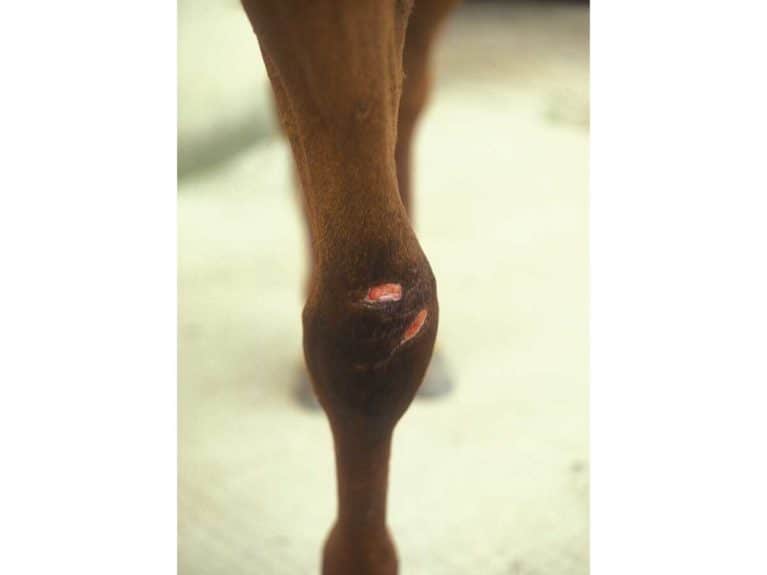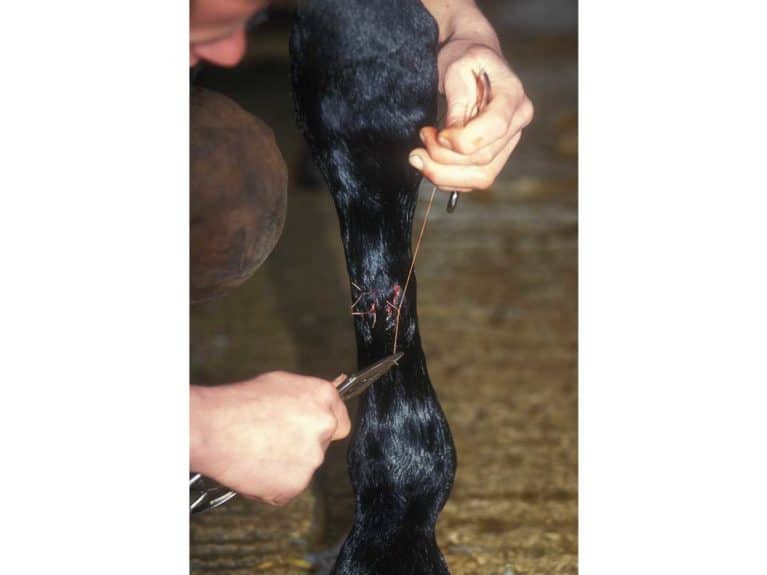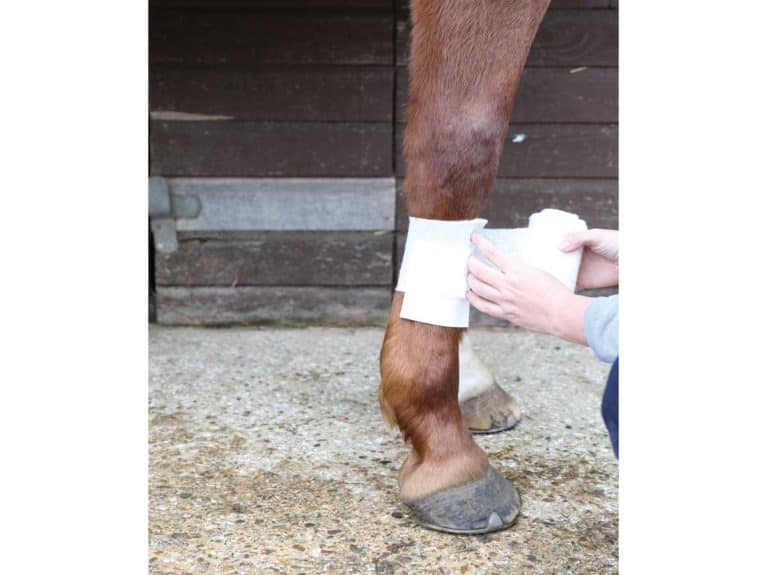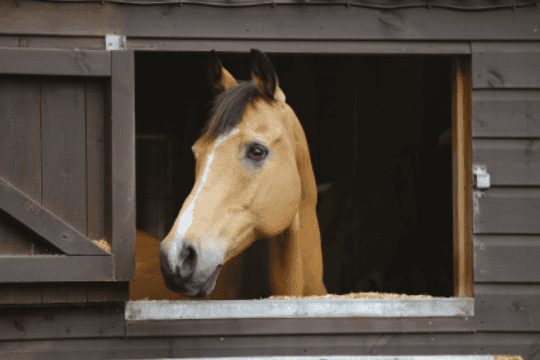Horses tend to be accident-prone, which means that dealing with wounds is part and parcel of being a horse owner. Vet Sally Hodgson, from Hook Norton Veterinary Group, explains how wounds repair and how you can help the process

Horses have an incredible ability to injure themselves on virtually anything and, quite often, the cause of a wound remains a mystery. But whatever the type, severity or cause, understanding more about how wounds heal will help you ensure your horse’s injury has the best chance of repairing as quickly and neatly as possible.
Types of wound
There are various different types of wound your horse can sustain. The most common include lacerations, puncture wounds and incised wounds. Other types include grazes, bruises, haematomas, contusions, complicated wounds and burns…
- lacerations are when the skin is torn in an uncontrolled direction and are usually caused by blunt objects. A common cause of lacerations is getting caught in wire
- puncture wounds are when a hole is created in the body by a sharp object. A thorn penetrating the skin or treading on a nail are two common causes
- incised wounds are cuts with clean, straight edges, similar to a surgical wound, and are usually caused by sharp objects such as metal, glass or flint
- grazes are small, superficial wounds that only affect the top layer of skin. They’re caused by abrasion from a rough, hard surface such as concrete
- bruises happen when tiny blood vessels are damaged, resulting in bleeding. They cause skin discolouration, but the skin is intact. Bruises are caused by a blow to the body or standing on something
- haematomas are swellings caused by a large volume of blood accumulating under the skin. Similar to bruising, they’re caused by a blow to the body, but often with more force
- contusions are severe bruising with damage to the skin. A common example of this is when a horse has been kicked and the hair and top layer of skin removed
- complicated wounds include any type of wound that involves other structures as well as the skin, such as joints, tendons, eyes, or the chest or abdominal cavities
- burns often affect the top layers of skin, but in severe cases can extend to the structures below. They can be caused by heat, extreme cold, friction, chemicals, hot water or strong sunlight
Skin deep?
A wound that goes all the way through the skin is described as being full-thickness. If it doesn’t go all the way through the skin it’s called partial-thickness or superficial. Grazes and contusions are examples of superficial wounds, while full-thickness injuries include puncture wounds.
The healing process
For a wound to heal, three processes have to take place and they overlap in time and space – this means that different areas of a wound may be undergoing different healing processes at the same point in time.
1. The inflammatory and debridement phase
Any dead or dying tissue has to be removed and bacterial contamination or infection brought under control. Inflammation is the body’s initial response to a wound and it brings immune system cells to the area to start cleaning up. This produces a thick discharge. Debridement means the removal of dead or damaged tissues. This phase may last up to five days.
2. The repair phase
Any tissue lost due to the wound is replaced in the repair phase. This usually begins within 12 hours of trauma but can’t be completed until the debridement phase has ended. The time taken to repair the damage depends on several factors, including how much tissue has to be replaced, how good the blood supply to the area is, and how long the inflammatory and debridement phase lasts.
Lost tissue is replaced by a layer of granulation tissue that brings new blood vessels and specialised cells called fibroblasts, which make tiny strands of a type of collagen. The granulation tissue is quite weak until 5–15 days post injury, when it becomes much stronger.
3. The maturation phase
A new top layer of skin must grow across the granulation tissue – this is called epithelialisation. New skin cells must move inwards from the blood vessels at the edges of the wound. Epithelialisation is a very slow process – at best the new cells can migrate 1.5mm in 10 days.
As the new area of skin forms, the blood supply behind the healing edge decreases and the cells shrink and become more densely packed together, forming a scar. This process is called contraction. Contraction contributes to the reduction in size of a healing wound by reducing the area needing to be covered by epithelialisation. Wounds can’t heal without producing some scarring, however massaging the scar tissue using aqueous cream may help to reduce the final size of the scar. Wound contraction continues for months after the wound has closed over.
Time’s a great healer
The time taken for a wound to heal depends on how much tissue is lost, with larger wounds usually taking longer to heal. However, there are several other factors that affect the healing rate…
- the presence of dead or dying tissue, foreign bodies or infection all prolong the inflammatory phase. This can be prevented by thoroughly cleaning and flushing the wound at an early stage, and by giving antibiotics when infection is present.
- movement of the wounded area slows healing considerably – one of the purposes of bandaging a wound is to keep the area as still as possible. This is why vets often recommend box rest for a horse with a wound.
- suturing (stitching) or stapling a wound helps to relieve pain and distress, and achieve a functional, cosmetic repair in as short a time as possible. It helps to decrease healing time by reducing the amount of new tissue and skin needed
to close the wound. This also reduces the overall cost of treatment – bandages and dressings can be expensive, so the less time they’re needed, the lower the overall cost.

Sutures are used where there’s tension across the edges of a wound – if a wound gapes open, there’s tension across it – and different types of suture can be used depending on how the tension is affecting the wound. If there isn’t any tension, staples can be used to hold the wound together. In general, wounds on the head are often suitable for stapling, but wounds on legs, especially over joints, usually need suturing.
A wound can be stapled or sutured if it occurred less than six hours previously. After this time, the bacteria contaminating the wound overcome the immune system and begin to impair healing, so older wounds should be left open to allow drainage.
Is it an emergency?
It’s advisable to call your vet out straightaway if your horse has a wound that’s near a joint, tendon, eye, nose or mouth, especially if it’s not superficial. Wounds in these sites can have very serious consequences if they’re not properly treated from the beginning, and wounds involving a joint or tendon can result in fatal infections if not treated early enough.
If you’re in any doubt, call your vet for advice – these days, photos are easily sent to your vet from a mobile phone. Make sure that any photos you send are in focus and clearly show where the wound is.
Vital vaccination
All horses should be vaccinated against tetanus – a fatal paralytic disease caused by soil-borne bacteria to which horses are very susceptible. If your horse isn’t vaccinated against tetanus, he’ll need to have an injection of tetanus anti-toxin, as even a tiny wound can allow tetanus spores in.
Wound cleaning
The first step in treating any wound is to clean it to remove dirt and debris. This is best done with large volumes of clean, running water such as drinking water from the mains supply – rubbing can drive particles of dirt on a wound surface deeper into the tissues and antiseptic can be damaging.
Once the wound is clean, a water-based wound gel should be applied under a dressing to provide the right moisture levels for healing to begin. The most important recent development in wound management is the realisation that wounds heal far better if they’re kept moist using wound gels and technical dressings. This is because moisture carries oxygen to the wound surface, and prevents cells from drying out and dying.
Once a wound gel has been put on, a dressing and bandage can be applied to protect it. This will also apply pressure to the wound and help to stop any bleeding.

Treat with caution
Creams, sprays and powders are best avoided, as they can do more harm than good. These products are usually very hard to remove once they’ve been applied, preventing your vet from being able to suture or staple the wound…
- creams trap bacteria and tiny foreign bodies in the wound
- aerosol sprays contain particles that act as foreign bodies in the wound and the pH (acidity or alkalinity) of sprays is often very different from the pH of body fluids, which can severely damage the cells that are trying to repair the wound
- powders dry out the wound, which is the opposite of what’s needed for optimal healing. The particles of the powder also act as foreign bodies
- honey has many beneficial properties for wound healing, but it’s advisable to use sterile, medical grade honey. Unsterilised food grade honey contains bacteria and fungal spores, including the bacteria that causes botulism and tetanus
Hard to heal
Occasionally, a wound won’t heal properly despite every effort to help it repair. Signs that a wound isn’t healing as it should include persistent or excessive discharge, proud flesh and pain in the area. Proud flesh is a term used to describe the excessive growth of granulation tissue, which fills in the wound during the repair phase. It’s considered to be proud flesh when it protrudes from the wound and starts to push out beyond the skin edges.
These signs tell your vet that there’s infection or a foreign body in the wound, or that an underlying structure such as a joint or tendon has been affected. The wound will need further investigation by your vet to find the cause of the problem, so it can be treated and allow the wound to heal.















